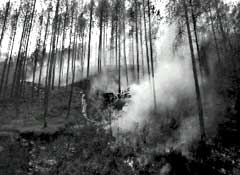Blowing out of proportion
 the slightest spark in a forest could turn into a major inferno, engulfing the entire vegetation in flames. This happens when the forest fire heats the air above it and fierce, high-speed winds cause the flames to spread. But surprisingly, scientists who study the behaviour of fires have rarely collaborated with meteorologists who study the wind factor. The result has been recurrent forest fires that fire-fighters have found difficult to control.
the slightest spark in a forest could turn into a major inferno, engulfing the entire vegetation in flames. This happens when the forest fire heats the air above it and fierce, high-speed winds cause the flames to spread. But surprisingly, scientists who study the behaviour of fires have rarely collaborated with meteorologists who study the wind factor. The result has been recurrent forest fires that fire-fighters have found difficult to control.
When a forest is on fire, the air around gets heated, becomes buoyant, and then begins to rise and spin. Scientists say vortexes of tornado-like strength can form, rising several kilometres in the air. These cause the fire to spread rapidly by dispersing embers. Researchers had so far found it difficult to directly study the manner in which wind and fire interact, as the turbulent air is very dangerous. "You never fly above a vertical column,' says Brian Stocks, a forester with the Canadian Forestry Service. Fires are also difficult to model because of their complex character and the chaotic nature of winds.
Now, scientists Mary Ann Jenkins from York University in Toronto, Canada, and Terry Clark, a meteorologist with the Boulder-based National Centre for Atmospheric Research in Colorado, us, have created a computer model that links models of the spread of fire with those of the behaviour of atmospheric winds during thunderstorms, to simulate what happens after a typical eucalyptus forest ignites. Their findings explain some key characteristics of forest fires and should eventually help fire-fighters predict how a forest fire will develop
